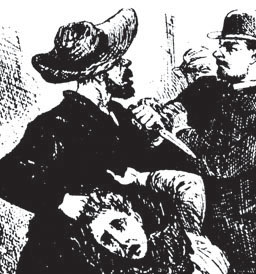

BY October 1888 the murders were generating huge public interest and hundreds wrote to the press and the police to suggest ways of capturing the killer or to offer information about his identity.
Newspaper tales of suspects inspired many readers to write to the authorities. Typical of these reports was the widely published story about a ‘suspicious’ man who entered a cabman’s shelter at Pickering Place, Westbourne Grove, Bayswater, on the afternoon of Sunday 30 September.1 He asked the keeper, Thomas Ryan, to cook a chop for him. The man was about 5 feet 6 inches tall, round headed, with a thick moustache and clean white hands. He was wearing an Oxford cap and a light checked ulster with a tippet. He had very restless eyes and seemed to have been drinking. Several cabmen were in the shelter talking of the two murders discovered that morning. Ryan exclaimed, ‘I’d gladly give a good deal if I could only find the fellow who did them.’ The stranger looked into Ryan’s face and said, ‘Don’t you know who committed the murders? I did them. I have had a lot of trouble lately. I came back from India and got into trouble at once. I lost my watch and chain and £10.’ The cabmen did not take the man seriously because he had been drinking. He then signed a temperance pledge for them as ‘J. Duncan; doctor, residence Cabman’s Shelter; Sept. 30, 1888’. He stated that he had nowhere to live at present, ate his chop, left and was not seen again.
On Tuesday 2 October J. Trustram of Harpenden, Hertfordshire, wrote to draw the attention of the police to this report which appeared in the daily papers that morning:
it is a singular thing this tale coincides with a man who escaped from Leaves[den] Asylum, some 12 months ago which cause a scare in this county and I have never heard he was captured it was report at the time he was a Doctor and came from India and was robbed his name was Macdonald, Now this man on Sunday signed his name Duncan if you have not already heard from Leavesden the authorities might give a description of Macdonald which may be serviceably…
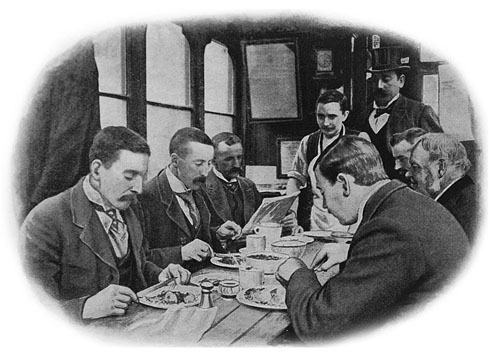
The ‘Cabmen’s Shelter’ story broke in the newspapers on 1 October 1888 and led to the identification of another suspect, John Davidson, who, according to Inspector Abberline, was seen by police and eliminated from inquiries. Shelters such as these were used by the hansom cab drivers for rest and refreshment and preserved examples may still be seen in London.
The Home Office received a suggestion that the same person be investigated from the governor of Newcastle Prison and requested a police inquiry. Inspector Abberline ordered the story thoroughly explored and the suspicious man was traced and interrogated. His real name was found to be John Davidson and he was able to account for his movements on the dates of the murders. He was thus cleared of suspicion.
As early as Monday 1 October, when maps of the murder sites were published in the newspapers, it was noticed that if the locations were joined together with crossed lines, a cross or dagger shape was formed. Writing to the Daily Telegraph,2 ‘Observer’ noted:
London, W., Oct. 1.
To the Editor of the ‘Daily Telegraph’.
Sir – In examining the chart representing the locality of the Whitechapel murders, published in your issue of to-day, it is curious to observe that lines drawn through the spots where the murders were committed assume the exact form of a dagger, the hilt and blade of which pass through the scenes of the sixth, second, first and third murders, the extremities of the guard making the fourth and fifth. Further, the spot where the portion of apron belonging to the victim of the Mitre-square tragedy was picked up lies in the imaginary line which forms the hilt of the dagger. Can this possibly afford a clue to the position of the next atrocity? –
I am, Sir, your obedient servant,
OBSERVER.
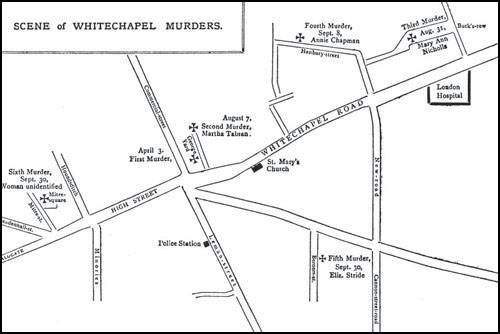
After the ‘double event’ of 30 September 1888 this basic map of the Whitechapel murders locations appeared in the Pall Mall Gazette. It shows the murder of Emma Smith on 3 April 1888 as the first killing and includes the murder of Martha Tabram on 7 August. Eddowes was shown as still unidentified when it was published.
A scene of cosy domestic life rudely intruded upon by the news of the horrible murders was painted by a Staffordshire lady signing herself ‘xx’. She also wrote to the police on 2 October with her idea about the murderer’s identity:
While sitting sewing and listening to my husband reading the London atrocities last evening a renewed and strong Presentiment came to my mind as to who the man might possibly be as near as I can remember it is about a year since we read in the Staffordshire Sentinel of a man who was writing letters of a very immoral character to different young women residing in the same locality where he lived the authorityes were informed and he was caught and turned out to be a young Clergyman the authorities said that they should inform the bishop and how the case went on I cannot say but from the underminded and diabolical manner in which he wrote those letters I think he would do anything from a feeling of revenge and wherever he lives ore whatever his occupation he is still the same man and I believe in my heart that he is the man. You might get more particulars from the Editor of the Staffordshire Sentinel.
The detailed newspaper accounts of the murders repeatedly inspired amateur Victorian detectives to suggest suspects that the police may not have considered. ‘E.C.’ wrote to the City authorities on 2 October after reading the report of the Mitre Square murder in that day’s paper:
it strikes me as strange the remark of the watchman, about the murderer – and also telling the constable who came up to his door to ‘Keep himself cool’ –
Now are you Sirs quite sure of this man’s character being good etc.,
‘E.C.’ was not the only correspondent to suggest that George Morris of Messrs Kearley & Tonge might be the murderer. The watchman theory was also put forward by ‘a maker and repairer of complicated repeater watches and chronometers, of Messrs. Swindon & Sons, Temple Street, Birmingham’. He wrote to the mayor of London stating that he had travelled in the United States and as a lad knew London very well. He felt that three things would allow him to ‘think the “devil” out’: first, a census of all lodgers returning home after 1.30 a.m. on the Sunday of the murders; second, whether the docks of London and the Commercial were open at night and whether there was a watchman who passed through in the early hours of that morning; and third, within a mile radius how many caretakers were in sole charge of premises from Saturday to Sunday last. If he could have this information he was prepared to identify the killer and to give all of the reward to ‘the London Charities … except £100’. He also required two weeks’ wages – he was paid £3.10 weekly – plus his train fare because he would need to be in London to carry out his investigation.
Edward Smith of 91 Upper Grange Road, Bermondsey, also felt that he knew who the murderer might be. To his mind the killer must have ‘a wonderful control’ over his victims. ‘It might be a person who is throughly well acquainted with the powers of an Electre Biologist’ as it would be easy for a man with such skills ‘to put the poor persons under his influence while speaking to them’. Mr Smith went on to say that twenty-five years earlier he had heard two people lecturing on these powers in South London. They were Professors Reynolds and Audrade who used to lecture at two different halls and who, he believed, gave lessons to pupils. Professor Audrade was, he thought, a salesman at the Metropolitan Meat Market in the early part of the day and gave his lectures at night. It had been suggested that the murders were committed by someone used to using a knife, possibly a butcher, and Edward Smith believed it might be worth the police checking at the market to see if there was any person there acquainted with the powers of an ‘Electre Biologist’.
There was also considerable correspondence purporting to come from the murderer – and not all of it was signed ‘Jack the Ripper’. One letter dated 2 October ended ‘M. Puddig Thrall [sic – Thrawl] Street, E.’:
You offer certainly a handsome reward but I have sworn that nobody shall earn it, this the one thousand eight hundred and eighty eighth year of our Lord. shall find me still at liberty untill its close, for not till I hear the first chimes of the church bells on watch night will I be tired of gloating over my work for hard work it has indeed been. thanks to my thorough proficiency in anatomical matters I gave them little or no pain, for humanity – they had to die, and at my hand. Still only a few more weeks and my task is done, when I shall ornament the scaffold that in short hours then and not till then shall you become acquainted with the motive of my crimes as you are pleased to style them [here there is a blot] was stern duty. They will forgive me when we meet in paradise, in celestial bliss. Amen.
M= Puddig-
On the same date William Dickinson of 27 Zetland Street, South Bromley, was inspired to write to the inspector in charge of the City Police Detective Department, Mr McWilliam. He enclosed a sketch plan of the six murder spots (he included the killings of Smith and Tabram) and indicated with dotted lines the murderer’s possible escape routes. From this he deduced that the culprit must live in a house close to Chicksand Street Board School and incorporated the position of the house on the plan. Undoubtedly, the criminal ‘devoured the accounts of his blood curdling work from the papers, which are supplied him by a near paper shop or lent by a publican close at hand’. He also felt that the killer was with his victims 5 or even 15 minutes before choosing a location for the murder and that he was well known to the women about the neighbourhood. He hoped that ‘these ideas or surmisations may be of some little use in unearthing such a terrible fiend as the now notorious Whitechapel murderer’.
The case also intrigued retired policemen. An old officer who had ‘been sent into Cornwall by the Lord Mayor of London in 1841’ had developed a theory built upon past Fenian problems. Henry Armitage of Ludgvan, Penzance, wrote on 2 October to Colonel Fraser and the ‘Chief Detective Department’ to say that he felt ‘an interest in the welfare of my country & anything I could do to throw light on this most dastardly case of murder’:
it has just occurred to me that you convicted an American Doctor for sending Dinamite, and by a person applying for the part of females inside they might possibly have wanted in America, by offering £20 for one if so if the Person who wrote that letter to the office which was stated in the newspaper on the Thursday before the last two murders was committed was the real murderer he was surely a Doctor and wrote it to throw you off the right scent and to deceive further by doing the daring deed again it looks more American than English was he an American Doctor or a Person connected with the one now in Prison and trying to Play off the Police for convicting one of their best men … there must be someone hiding this murderer is it a Catholic Dinamite or an American Doctor it was no madman that wrote that letter, it might have been an accomplice.
Henry Armitage was persistent and wrote again the following day to comment upon the use of the word ‘Boss’ and the ‘daring exploits of the Irish American Dynamiters in London’. He thought that the letter signed ‘Jack the Ripper’ was written by an accomplice and wondered which Fenian dynamiters might be missing from New York. He was sure that the murders were all in revenge for the conviction of the American doctor ‘some time since’.
Armitage wrote a third time on 8 October to thank the City Police for the acknowledgements they had sent him and to say that when the last letter signed ‘Jack the Ripper’ stated he was going to Brighton to ‘kill a Dutchess’, Armitage thought that he had made Whitechapel: ‘too hot for him and perhaps he had gone back to America to show his trophies to the fenians & that we should not hear of any more murders just yet, and the one that writes the letters is writing now to deceive whilst the other the murderer gets away’. Three further letters from Henry Armitage on the subject, dated 28 November 1888, 19 July 1889 and 27 October 1889, are on file with the City force’s correspondence. Checks by the police confirmed that the elderly Mr Armitage had indeed retired from the force in 1841.
Inspired by a letter written by Archibald Forbes and published that day in the Daily News, J.F. Boyd of 45 Bugle Street, Southampton, wrote to the City commissioner on 3 October. He thought that the murderer was ‘the same gentleman who gave Mr. W.E. Baxter the Coroner the false information about an American who offered him £20. per uterus’.
The deluge of mail that followed in the wake of the ‘double event’ on 30 September brought with it many other putative suspects. Then, as now, theorists plucked names from the contemporary newspapers. Even the great self-appointed Ripper hunter Dr Forbes Winslow did not escape the attention of the amateur sleuths. C.J. Denny of Milestone House, Blackwater, near Farnborough in Hampshire, medical officer for the Hartley Wintney Union, Rural Sanitary Authority, wrote on his headed stationery to Sir James Fraser to communicate his suspicions:
I saw some weeks back a letter (in the Globe I believe) from Dr. Forbes Winslow dealing with the subject of insipient insanity. It struck me as strange that the night or the morning after this letter appearing one of these murders was committed, according to all accounts by some one possessing a knowledge of surgical anatomy. I have never spoken to nor do I know Dr. Winslow, even by appearance, but from letters I have seen as purporting to come from him & from what I have heard of him, I cannot but think that he must be a man of a very peculiarly constituted mind, & one who, possibly suffering from some incipient form of insanity himself, wd go any lengths to prove his case in order to bring about an alteration in the law. Should you consider my suspicions – wh I grant you may be far fetched – worth anything you will know just what to do…
The hunter hunted! Denny suggested comparing the descriptions of parties allegedly seen with the murdered women to Winslow and perhaps even searching him. He ended by stating that he would, of course, claim the reward should his ideas bear fruit.
A most extraordinary suggestion as to the identity of the murderer was sent to the City Police on 3 October. Mrs L. Painter of Burlington Lodge, Strand, Ryde, wrote to say:
No one seems to think of the possibility of the slayer of the six women at Whitechapel being other than a man, but it may be in fact woman or neither one nor the other. it may be a large animal of the Ape species belonging to some wild beast show. The animal would be swift, cunning, noiseless and strong, standing over its work until a footstep was heard and then vaulting over fence or wall, disappearing in a moment, hiding its weapon perhaps high up in a tree or other safe place, and returning home to shut itself up in its cage. There are, I have heard, a number of wild animals kept in a house in the heart of London, I think in Whitechapel, being allowed an extraordinary amount of liberty.
Mrs Painter went on to comment on the ‘unfortunates’ that ‘nothing but fear for themselves’ would remove from the streets. She commended her ideas to the police for consideration.
The idea that the killer might be making his escape via London’s sewers occurred to more than one correspondent. On 3 October Frederick Allison of Gordon Street, Plaistow, wrote to Sir James Fraser with this suggestion; he added that the killer might also be ‘dressed in the garb of a sewerman’. ‘Supposing,’ he went on, ‘the murderer of last Sunday went down a grating say in Houndsditch or Aldgate & came up in Cheapside…’
E.W. Clark of the post office, Addiscombe, Croydon, ‘Like all English men’, was ‘shocked at reading of these horrible murders’ and in a letter dated 3 October he gave his ‘humble opinion’ on the identity of the murderer to the City Police. He felt it was ‘more the work of a Slaughterman’ and thought that ‘the evidence of the one who was examined at the Inquest about Sept 3 was very peculiar’. After all, such men ‘understood exactly where to strike, and they would not be noticed so much if there was blood on them’. Mr Clark felt that it was worth watching slaughterhouses to see who went out after midnight and commended the police to read ‘that evidence particularly the remark he made about the women of that part’. Clark was obviously referring to Henry Tomkins, employee of Harrison, Barber & Co. in Winthrop Street. During the inquest, Tomkins had been asked by the coroner, ‘Are there any women about there?’ He replied, ‘Oh! I know nothing about them, I don’t like ’em.’ The coroner said, ‘I did not ask you whether you like them; I ask you whether there were any about that night.’ ‘I did not see any,’ Tomkins responded.3
Writing on 3 October, John S. Gordon of 9 Bridge Street, Aberdeen, informed Sir Charles Warren that:
there is a Dr. Hartley, here selling a patent medicine named Sequah or Indian medicine, Now I believe this man and the Whitechapel Murderer & Mutilator have some connection. Set a watch on this patent medicine man. Examine all bottles & parcels that may be sent to him.
The Star of Thursday 4 October reported that the ‘Whitechapel craze’ had extended to the genteel neighbourhood between Upper Norwood and Croydon, where a belief was held by many people that the murderer found a hiding place in a dense wood skirting Leather Bottle Lane and leading on to Croydon. Gardeners in the employ of Mr Horne, the owner of the wood, had seen a man dressed as a woman lurking there at night. Since August, on each of the nights that a murder was committed, this person had been seen to enter the wood. The gardeners had duly armed themselves.
The Star also reported on the arrest on the night of Wednesday 3 October of an American suspect who refused to give his name or any account of himself. He was well dressed, rather tall, of slight build and clean shaven. He had accosted a woman in Cable Street and asked her to go with him. He had threat-ened that if she refused he would ‘rip her up’. The woman screamed and the man rushed to a cab. The police gave chase, got on to the cab, seized the man and took him to Leman Street police station where he had asked the duty inspector, ‘Are you the boss?’ He was detained along with two others who were taken there the same evening. One of the men had gone up to an officer in the street and said he ‘had assisted in the Mitre-square job’. The constable duly took him to Leman Street where it was found that he was suffering from delirium tremens. The Star said he was held pending further inquiries and was released at 10 o’clock that morning, inquiries having shown that his account of himself was entirely satisfactory.
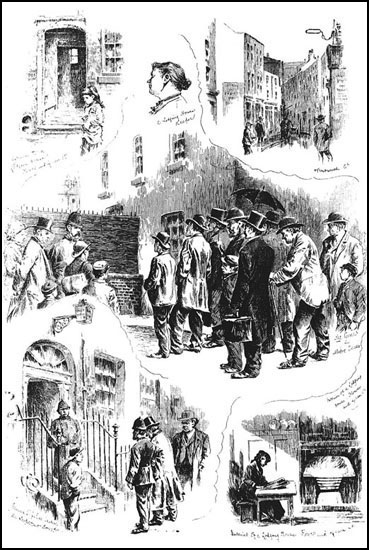
Aspects of the murders, including sightseers at Mitre Square (centre), as reflected in Pictorial World in 1888.
The Star of the East of Thursday evening, 4 October, reported a Press Association story that excitement continued to increase in Whitechapel. Should the miscreant fall into the clutches of a Whitechapel mob, it ‘will go hard with him’, the paper said. Late on the Wednesday night repeated reports had been received that the murderer was captured. Shortly before midnight a story circulated that the unidentified killer had been surprised in the act of ‘attempting another outrage’ on a woman in Union Street, Whitechapel. This was obviously another version of the American suspect story which stated that the woman was lured by the ‘monster’ into a side street, but the gleam of a steel blade alerted her to danger. Her screams brought to her assistance a man and two women who were said to have been watching the movements of the couple. The would-be murderer, it was stated, was pursued by a man who knocked the knife out of his hand. However, the unknown attacker then jumped into a passing cab, bidding the cabman drive wherever he liked. A howling mob swarmed after the fugitive and the police soon captured the vehicle, taking the occupant to Leman Street police station. The woman nevertheless declined to press any charge and left the police station. The man was described as ‘an athletic determined fellow, of about 43 years of age’. No weapons were found on him. He gave a name, but refused to give his address. He conversed with a slightly American accent. When he was removed to the cells his attitude became defiant.
About 6 p.m. on Wednesday 3 October, a man, whose name was ascertained to be John Lock, a seaman, was rescued by the police from an excited crowd in the vicinity of Ratcliffe Highway. The crowd pursued him shouting ‘Leather Apron’ and ‘Jack the Ripper’. When Lock was examined at the police station, his light tweed suit was found to have paint stains which the crowd had mistaken for blood. His explanation for his appearance was perfectly satisfactory, but it was some considerable time before the crowd dispersed and it was safe for him to depart.
While Eddowes’ partner John Kelly was making his statement at Bishopsgate Street police station on 3 October, a man entered and confessed that he was the murderer. He strongly objected to being searched but had to submit when he was approached by two or three constables. He was detained and charged the next day at the Guildhall police court. He gave his name as William Bull, describing himself as a medical student at London Hospital. He appeared to have been drinking heavily. Inspector Izzard said that when Bull came into the station he claimed to have committed the murder in Aldgate, saying that the clothes he had worn were in the Lea and the knife had been thrown away. The prisoner was not known at the London Hospital but his parents were very respectable. In answer to the alderman at the police court, he said he was mad drunk when he made the statement and it was impossible for him to have committed the murder. He was remanded, the alderman refusing to grant bail.
Members of the public swamped the police with plans for how to trap the murderer and suggestions about who he might be. The most popular scheme was to dress police officers as women, arm them and thus lay a trap for the killer. Interest in the London crimes was truly national. On 4 October John S. Gordon of Aberdeen wrote again, this time to advise that information should be sought from all hotel porters and waiters regarding guests who had returned to their rooms about the time when the murders were committed. Mr Gordon also made the suggestion that detectives should dress as women and then added a postscript with his very own theory as to the identity of the killer – ‘See where James Malcolm the Bigamist is, he is a Butcher and may have taken a hatred to women.’
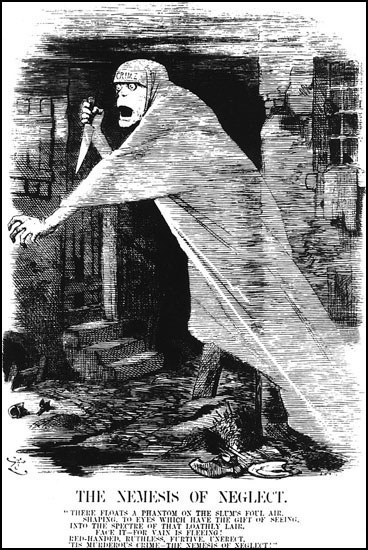
‘The Nemesis of Neglect’, Punch, 29 September 1888.
The same day Mary Heard of North London wrote to the City Police headquarters with the comment that the murderer was ‘the Lunatic who escaped some time ago from Leavesden’. She added that the police might find him with the aid of the keeper who had been in charge of him at the asylum.
Another female correspondent wrote the same day to the Mayoress, Lady de Keyser, with an idea which she asked to be placed before the lord mayor. She was Mrs S. Luckett of 10 Somerford Grove and she had been scanning the letters pages of the newspapers. She suggested that A. Eberle Evans of Hillcote, Ilkeston, writing that day in the Standard, should be interviewed, as should C.H. Presgrave of the Conservative Club, Manchester. She further proposed that board schools and other educational establishments receive surprise visits from detectives. The children, she said, should be questioned class by class about where they lived, how many others lived there too and whether these people were relations or strangers to them. They should also be asked whether those who shared their house were of the same sex and what their habits were. Inquiries should be made as to the position of single-person households and the habits of their occupants. These homes should be particularly watched, Mrs Luckett thought. She then asked, ‘Who is the author of ‘Dr Jekyll & Mr. Hyde? Is he a capable & likely individual to be the perpetrator of dire offences?’ – surely a first in suggesting Robert Louis Stevenson as the Ripper! She rounded off by stating that eight trained bloodhounds should be placed in pairs at police stations at the four points of the compass ‘instead of only at Whitechapel for doubtless the ruffian will take hints & vacate other quarters’.
In the batch of suggestions sent on 4 October was a letter from ‘Scotus’ of Southampton to Sir James Fraser. It said that ‘a clue for the perpetrator of the recent crimes’ might be obtained if inquiries were made at the various London hospitals and of ‘medical men about the East of London’ as to whether any very bad case of ‘phogdoena’ was under treatment: ‘My theory of the crimes is that the criminal has been badly disfigured by disease – possibly had his privy member destroyed – & he is now revenging himself on the sex by these atrocities. He has no doubt made up his mind also either to hang or to commit suicide if my conjecture is right.’
The idea that a police officer was the murderer was popular and on 2 October S.A. Ashby of 43 Acacia Road, Regent’s Park, wrote to the City commissioner suggesting that the murders ‘may have been committed by some human fiend in the disguise of a policeman’ in order to evade detection. Then on 5 October an ex-patriot, John Hoyer, ‘Artist Tailor’ of 315 Broome Street, near Forsyth, New York, wrote to the lord mayor of the City of London:
Nobody else can be the Villain but one of your Finest (as we call them) or may a Superior.
Hoping the mystery be solved at a early Hour, and that I may be wrong.
But you Oblige me by giving this a Investigation and oblige…
Also on 5 October ‘M.P.’ wrote to the City authorities having just been to see 34-year-old American actor Richard Mansfield4 playing Dr Jekyll and Mr Hyde at the Lyceum. ‘M.P.’ was much impressed with the performance and had no doubt that Mansfield was none other than the murderer.
The popular idea that the murderer might be a Jewish slaughterman was explored by J.W. Causier of Yetminster near Sherborne in Dorset. In a letter to the City police dated 5 October he enlarged upon the suggestion which he had already made in a previous letter. He believed that such men were ‘a sort of minor priesthood holding a license to kill from the Chief Rabbi’. They were therefore easily traced; some were foreigners and they were much more respectable than the majority of slaughterers. It was evident to Mr Causier that the murderer (or murderers) must be well acquainted with Whitechapel and Jewish slaughtermen could move about the area without rousing suspicion. He ended by asking, ‘Have the offices connected with the Great Synagogue the one in Bevis Marks been searched?’
‘W.G.’ of Gloucester Walk, Kensington, wrote to the City authorities on 5 October after reading a letter by a Mr Evans published that day in the Standard. He recalled that some time ago there had been two individuals charged at separate times for disturbing the services at St Paul’s Cathedral. They were evidently ‘Religious monomaniacs’ and were identifiable, he said. One was believed to be respectable, a solicitor – ‘or called himself one’. The man was over 60 and had no practice. ‘W.G.’ stated:
I have met the latter on 2 or 3 occasions and although at times very plausible his conversation often falls into boasting of his great strength inviting others to stand upon his bare breast &c I certainly dont believe he is capable of such villainy but thought I would mention these circumstances. He is an occasional frequenter of Turkish Baths and I may mention that walking is no trouble to him.
N. Hollander of 28 Stratford Road, Kensington, had been avidly scanning reports of the murders in the papers, including Bachert’s account of his encounter with a suspicious man in the Three Nuns in Aldgate. Hollander had an idea that the individual Bachert saw was a local man and he wrote to Colonel Fraser about him on 6 October:
There used to live a surgeon in the Abdingdon [Abingdon] Rd Kensington, or at least he had a surgery there. I think Doctor Sass or Sassy I cannot exactly say which he called himself – he was a Dr. of some club!! Now this man is the exact stereotype of a man seen by the man Baskert in the 3 Nuns Hotel Aldgate.
This Dr. is greatly reduced in circumstances, in fact, is loafing about like a tramp. I have seen him principally in the Parks of late; he is certainly a strange mannered man. I have seen him play with his bag like a big school boy. He always carries a black bag & wears black gloves.
It was about two years since this doctor kept a surgery. It seems very likely that he was eccentric or suffering from mild mental illness, but harmless. We do not know if the police made inquiries to trace him. Doctors were popular suspects and ‘R.C.N.’ of Bristol wrote to the City Police on 6 October with the information that:
An American Doctor was in Bristol last Winter – he called himself ‘Sequah’ – he dressed like a Cowboy – he is not unlike the picture in the Telegraph of the 6th inst – Packer’s description – square built – Height 5ft 7in age about 28 – full in the face, Dark complexion without moustache & alert looking – Black long hair – soft hat and long coat would just suit.
The police did not acknowledge this suggestion.
An interesting unsigned letter was sent to the City Police on 6 October asking if the London Hospital had been thoroughly searched:
Is there no one there doing ‘clerking’ &c. who has acquired a little surgical knowledge. May have watched the use of the knife. May have access [to] certain knives and possibly drugs may know how to keep the victims silent by pressure on certain nerves in the neck and also how to preserve his own person and clothing comparatively unstained. It did not take a long time to return to his quarry from Mitre Square even[?] after scribbling a litt[?] via Goulston Street.
Another letter sent in the early part of October is undated. It is signed off by ‘a stranger O.X.X.’ and was sent to the City Police. The author stated that she had written to Scotland Yard regarding the facsimile of the original ‘Jack the Ripper’ letter which had been published in the Daily Telegraph: she felt she recognised the writing. She now wrote again in order to give the man’s name because ‘some month back’ he had said ‘it was a very easy thing to do – what is now being done to the Poor women at the east end of London’. The correspondent went on:
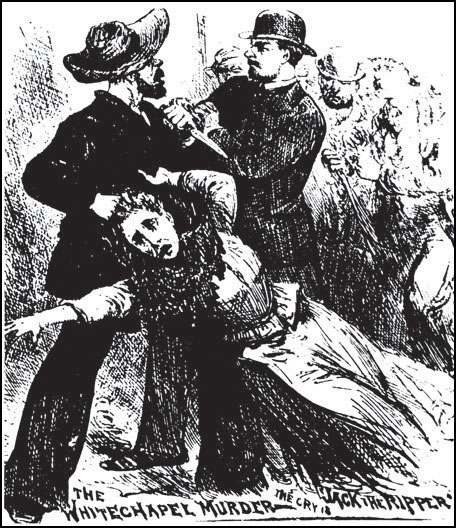
A popular image of the Ripper.
… he is a short man rather & I had to dry a jacket for him & women like I felt in his pockets while doing so & found his name was Galer or Galar & he often talk of the Brompton Hospital & a old nurse at the out Patients Part & what I now rember the number on the letter was either 13 or 31. South Place Chelsea.
The writer, wishing to remain anonymous, said that she would watch the Daily Telegraph for the letters ‘O.X.X.’ in the paper and she would answer any query. She committed to this against the advice of her friends who had told her to have nothing to do with it.
Not all suggestions received by the police were outlandish. On 6 October John Bland of 95 Sinclair Road, Kensington, wrote to the City Police commissioner suggesting that the murderer was:
a watchman left in solo charge of one of Jewish houses in the City that are closed from Friday till Monday. If this were the case he would have plenty of time to wash away all traces of his crime. After he had done the Berner St murder he would probably make straight for his house so as to be out of sight before the ‘hue and cry’ was raised and the fact of his appearing in Mitre Square afterwards would tend to show that he lives in the direction of the City from Berners [sic] Street.
But Mr Bland also had a suggestion as to the actual identity of the killer, mentioning the widely discussed ideas that the murderer was a mad doctor and a religious fanatic:
There is a poor lunatic named Herbert Freund who has been in the hands of the police several times for disturbances in St. Paul’s. I do not know anything whatever against this man, whom I have never seen, except that he was educated for a doctor and he went mad on the subject of religion.
The Whitechapel Vigilance Committee had been formed on 10 September and its activities received wide publicity in the newspapers. The committee itself was to be the inspiration for further suspect stories and reports of odd incidents. The press pointed out that the murderer not only had to avoid uniformed and plain-clothed police officers but also had to ‘reckon with a small, enthusiastic body of amateur detectives’. The duties of this band were twofold. It was to publicise far and wide its disagreement with the home secretary by offering a substantial reward to ‘anyone – citizen or otherwise’ who could give information that would bring the murderer or murderers to justice. In addition, its members patrolled the most secluded parts of the district in the dead of night with a view to running the criminal to earth. Unfortunately, those to whom they appealed for financial help were more ready to commend than to support. Excluding one or two substantial subscriptions, they were forced to admit that funds had not ‘rolled in’. A suggestion that a large public meeting might be held to further the objectives of the ‘Vigilants’ was not responded to with alacrity. Undaunted by the disappointments, the committee worked persistently on. Night after night, at 9 o’clock, meetings were held in the upper room of a pub in the Mile End Road which had been placed at the disposal of the committee by the landlord, who was also its treasurer. The leaders of the group were principally tradesmen and included a builder, a cigar manufacturer, a tailor, a picture-frame maker, a licensed victualler and an actor.
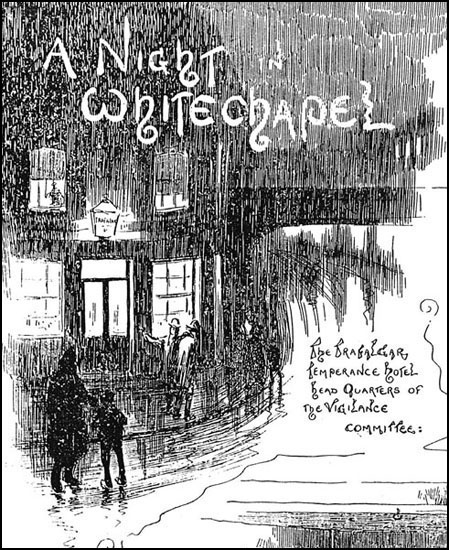
The Trafalgar Temperance hotel, headquarters of the Whitechapel Vigilance Committee.
Inexperienced in practical police work, they decided to call in professional assistance rather than rely solely upon their own resources. For this purpose they engaged the services of two private detectives, men who claimed to be ‘experts in the unravelling of mysteries’.5 About a dozen men with intimate knowledge of the neighbourhood of Whitechapel were placed at the disposal of those executive officers. Those selected were deemed to be ‘physically and morally equal to the task they may any night be called upon to perform’. As they were drawn from the unemployed, it was not necessary to pay a high level of remuneration.
Shortly before midnight these ‘assassin-hunters’ were dispatched on their mission, their tread silenced by the use of galoshes and their own safety assured by carrying police whistles and stout sticks. The area they covered was divided into beats and each man was assigned his respective round. At 30 minutes past midnight committee rooms had by law to close and then the members who happened to be on duty emerged. Like police sergeants they made their tours of inspection, seeing that their men were faithfully performing their onerous duties and they themselves visited the most isolated and ill-lit spots. The volunteer policemen finally left their beats between 4 and 5 o’clock in the morning. It was not possible for members of the committee to supervise every night because most of them were engaged in their own businesses from early in the morning until late. Although the Whitechapel Vigilance Committee’s men met with no success, it was claimed that they gathered much information that could be of future use. The regular police were not affected in their own endeavours to bring the criminal to justice. Suspicions, surmises and possible clues were notified to the nearest police station from time to time and it was reported that ‘one member of the committee at least honestly believes that he is on the right track.’
Even without the help of the Whitechapel Vigilance Committee the police were not short of named suspects to either dismiss or investigate. On 6 October W.R. Collett of 104 Upland Road, East Dulwich, wrote to the City commissioner to name a man he had met the previous July while staying with his wife in a boarding house – Portland House, Havelock Road, Hastings. Mr Collett discovered that the man, who was named Willie Boult and aged about 30, had ‘surreptitiously left’ his employ with a firm of solicitors called Jacques in the WC district of London to move to the house in Hastings. According to Collett, it was apparent that he was deranged and in a few days he ‘became an alarming lunatic’. His friends were called in to take him away to live with his mother in Fulham. The man’s telling traits were that:
He developed most tragedical ideas, reciting or singing things of that nature at all times of the day & night, accompanying his actions with a knife –
He brought a small Gladstone Bag of black shiny leather with him, which he carried at all times, with his knife inside (an ivory handled one with a blade about 4 inches long)…
Such behaviour, said Mr Collett, made it possible that ‘such a maniac would be a dangerous character if suffering from any injury inflicted on him (whether imaginary or real)’ and he felt that the police should trace Boult as it was possible he might be guilty of the crimes.
Also on 6 October, ‘Watchful’ of the City of London wrote to Major Smith of the City Police with the warning to: ‘Watch G. Weston & Cos, Electricians, 40 Burdett Rd., Mile End. There is one or more American employed there acquainted with life in Texas & other Western states.’
Sarah Fremlin of Park View, Loore Road, Maidstone, Kent, wrote to the lord mayor of London on 7 October to say that she suspected a person who was staying with an old gentleman, a doctor, she had known some years previously in a village where she then lived and kept a school. The man in question had approached her to ask if she would accommodate his three children and housekeeper for a few weeks because he wanted them to receive the benefit of the country air. She did this and then learned that the man’s London address was Oxford Street, Whitechapel. She subsequently discovered that the man’s wife was not dead but had left him, the fault being hers. The doctor died and the man arranged his funeral. After this, he left with his family and she had not seen him since. If he was still alive, the man would now be aged between 50 and 60 years. She could give his name ‘if required & necessary for the furtherance of Justice’.
On 22 October, good as her word, Sarah Fremlin again wrote, to the City Commissioner, desiring ‘to aid you all I can in the detection of the East end Miscreant’. Further to her previous communication, she could now name her suspect as John Davis, although the name appeared as Thomas Davis in a press cutting of a case in the Westminster Court where he was described as an elderly man, an agricultural worker, who had been charged with begging in the Fulham Road. She claimed that the doctor had referred to him as ‘Jack & often Jackey’, thus confirming her suspicions.
The East Anglian Daily Times of Saturday 8 October had further news on suspects:
THE
EAST END ATROCITIES.
ARRESTS AND DISCHARGES.
AN AMERICAN STORY.
[CENTRAL NEWS TELEGRAM]
NEW YORK, Friday Morning.
The atrocious crimes committed in Whitechapel have aroused intense interest here. The following statement has been made by an English sailor named Dodge. He says he arrived in London from China on August 13th by the steamship Glenorlie. He met at the Queen’s Music Hall, Poplar, a Malay cook named Alaska. The Malay said he had been robbed by women of bad character in Whitechapel of two years’ savings, and he swore that unless he found the woman, and recovered his money, he would murder and mutilate every Whitechapel woman he met. He showed Dodge a double edged knife, which he always carried with him. He was about 5ft. 7in. in height, 130lbs. in weight, and apparently 35 years of age. Of course he was very dark.
The ‘Malay Cook’ story had appeared in the Daily Telegraph on 6 October and there is little doubt that the name ‘Alaska’ was actually a misinterpretation of the ethnic description ‘a Lascar’ (an Indian sailor). This story had struck John Binny of 13 Tavistock Place, London, who wrote to the City Police superintendent on 6 October. Mr Binny felt that the story may be ‘a ruse of the assassin or one of his friends’ to put the detectives off the scent. He felt it was worth the police having inquiries made of Dodge in New York and told them they should obtain a description of the Malay. Binny had also read that a Malay was also among a group of men recently arrested and that he had been freed. Mr Binny compared descriptions of suspects given in connection with the Stride murder and the Malay. For the information of the police he enclosed a copy of the relevant newspaper article.
W. Cunliffe of 33 Harcourt Road, Brockley, SE, wrote to the City authorities on 8 October detailing suspicions he held in relation to a German man, H.C. Kromschroeder of St John’s Wood, who had been employed as a draughtsman at Woodhouse & Rawson’s, electrical engineers, Cadby Hall Works, West Kensington, until midsummer 1888. Just prior to leaving this employment the German had showed his fellow employees in the office ‘a large & dangerous looking knife [apparently] of the Bowie type’ which caused some interest. He then buckled it on to his waist to show how completely it was hidden. According to Mr Cunliffe, the man had openly declared that he was ‘in the habit of associating with women of loose character’, used phraseology that corresponded with the published letters of ‘Jack the Ripper’ and employed:
the most vengeful & bitter expressions of hate & violence towards both Frenchmen & also loose women, and speak of ‘ripping them up’ – But on the other hand, once whilst I remonstrated with him for speaking & feeling so bitterly against such women – He admitted that they had helped him in needy circumstances, and therefore, he was under great obligation to them for that help.
However, the writer was still ‘very forcibly struck’ by the similarity between this man’s words and the Ripper letters. Although Kromschroeder professed to be a German subject (Hanoverian), he spoke very good English without a German accent. In fact his accent seemed to hail more from Birmingham, the North or Lancashire. The man had tastes of ‘a low & vulgar type’ and his expressions were at times ‘most disgustingly horrible and bloodthirsty’. His evident hate, malice and morbid character impressed Mr Cunliffe who also felt that his man resembled the first of the two suspect sketches reproduced in the Daily Telegraph. He said Kromschroeder wore a diagonal cloth coat, an overcoat similar to one described in the papers as worn by a suspect, and a stiff brown billycock hat. The man was a frequent visitor to the Hound & Flower pub near Addison Road station and the Beaconsfield near the Olympia. Cunliffe had become quite friendly with him and had visited both premises with him. Kromschroeder told Binny his mother was English and his father German.
The terrible murders had greatly affected B. Barraclough of 1 Woodview Terrace, Bradford. He wrote to the police on 9 October stating that his children had been experimenting with ‘table rapping’ and not only did the table respond with the words there would be ‘more murders tonight in London’, it also revealed the identity of the murderer. He was ‘Tom Totson, 20 Wurt Street, W.C.’.
Another 9 October correspondent, W.J. Smith of Red Lion Passage, Holborn, had further suggestions for the police. His letter to Fraser identified a deep and dark motive behind the murders:
Motive
A week or two ago I noticed a poster of the Star saying, War on Warren, I have been daily looking for the outbreak in any form & I admit it is apparent in the Horrors they thought by Demoralising the Police force they would make government impossible that Lord Salisbury would resign and Gladstone come in and the ruin of the Empire certain – and their cherished object gained a (Republic) God Forbid.
Mr Smith had a suspect. In 1881 a 21-year-old Hungarian had applied to him for a lodging despite being unable to speak English. The man was very clever and soon learned the language. He had strong communist sympathies and knew that Mr Smith was ‘a loyal Conservative’ but wanted to ‘be very intimate indeed’. He was propagating revolutionary literature in German and English with imported books. Many of his German customers were at the ‘Lager Beer Distillery Tottenham & at Soho & Leicester Square & all over London … he has also had 2 or 3 Situations as Manager at a Salary from the Jews who I believe he hates & persecutes as well as the english workmen & Girls whom he is over & can sack or take on at his sweet will’. Mr Smith feared that the foreign socialists were taking over and that the situation was desperate. He then went on to list the suspicions he had regarding individuals:
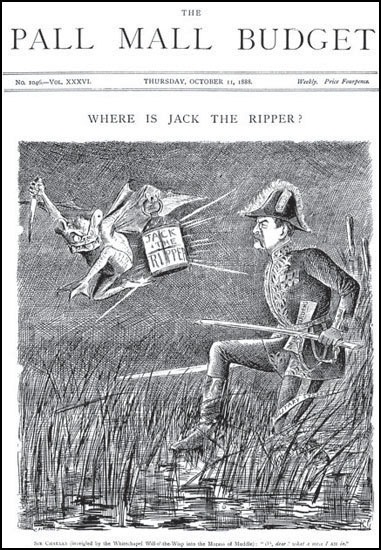
Sir Charles Warren lampooned in the Pall Mall Budget of 11 October 1888.
no doubt you will pay some attention to the Tottenham address they have recently changed there [sic] Watchman the last I think his name was Lemon I heard he was to open a shop Eating house in Hollywell Lane E & doubtless these 2 friends found the substitute, there is a Hungarian Club in Burt St opposite the British Museum, do you know anything about it I think the caretakers name is Hoot he has been a great traveller in his time, since April to September this year he has been travelling & visited Dublin I have some doubts about him also a Man Travelling for Henry Pound Bag Maker Leadenhall St. his name is Garrod, if you could find all the places he went to in England & Ireland between April & Sept last, & if all his business was legitimate. I fear he was agent for the socialists at the same time I know he received a good deal of money & I thought his movements very suspicious I would like to add I know a Mr Mac Sweeny I hear he cost his father 600 Pounds for his Education he was educated at university college Hospital. Previous to his present situation 4 years ago he was in America, some time, and always uses the dialect Boss &c. might not a man with his education instruct others in dissection.
It is interesting to note that Mr Smith’s theorising encompasses all the popular themes of foreign anarchists, Irish links and an American connection.
Writing to the City authorities, also on 9 October, J.J. Beckett, a barge owner and contractor of Union Wharf, East Greenwich, informed the police that he believed he knew the identity of ‘the person who is likely to have committed the late murders in Whitechapel’. Mr Beckett was at Greenwich police station on Friday 5 October and there he saw a copy of the letters said to have been written by the Whitechapel murderer. The writing and language of the letters struck him as familiar and:
in pondering over the matter it came forcibly to my mind that one James David Lampard was the party whose writing and language they represented. I was the Proprietor of the house known as the Ram & Magpie, Fleet Street, Shoreditch and he was one of my most frequent customers and I have been often alone in his company and have had both time & opportunity to study this man and know him well. In former years this man was in affluent circumstances and had travelled both the European and American Continents he had stayed some little time in America and often addressed me as the Boss and other slang American terms. He led a life of great profligacy and this had brought him to a condition little better than beggary. He was most excitable and was fond of causing fierce excitement at one time he broke his arm, and set it again himself tearing the sleeve of his shirt for bandages. He had a great taste for anatomy & had dissected and stuffed different animals & birds. He was a good scholar and I have heard him speak of the human body in a very learned manner.
So struck was Beckett by the likelihood of Lampard being the murderer, he made inquiries about the man in Whitechapel on Saturday 6 October among people who knew him well. They told him that Lampard had been ‘out of his mind’ and had been a patient at the London Hospital, from whence he had been sent to a convalescent home. However, since his return he had been leading a life as dissipated as before. He had, apparently, ruined his father, who was now destitute. Mr Beckett felt that Lampard fitted the description of the murderer, given by a doctor in the Chronicle, as an educated man who had been insane but had been discharged from a hospital supposedly cured. Also, Lampard knew ‘every corner in Whitechapel’, and had lodged in most of the lower-class lodging houses in the area. Beckett described his suspect as about 5 feet 8 inches in height, well knit and broad-shouldered. He had the appearance of a military man with ‘a very authoritative tone of voice’. He had a red face, pointed moustache, no whiskers, dark hair, a high forehead and was bald in front. Even when badly dressed, he still retained a gentlemanly appearance, sometimes wearing a high hat and frock coat, and at other times a round felt hat, long coat or dress coat and sometimes a peaked cap. Lampard had been seen going through Fleet Street, Shoreditch, on the night of Thursday 4 October much the worse for drink. It was believed that he lived somewhere in the neighbourhood and was well known to residents.
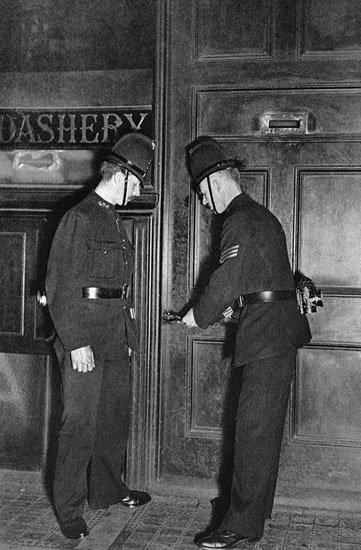
An early photograph of City of London Police officers checking the security of doors while on night duty. Note the old bull’s-eye oil lanterns attached to the officers’ belts.
An anonymous accusation against an ex-police officer was sent to Sir James Fraser on 12 October. ‘I am about to make a serious accusation,’ the writer began, ‘but, if followed up, I am certain with good result.’
There was a man in your force Stationed at Seething Lane for some considerable time as Constable, but he has been discharged I think about 12 months – When he joined, I am possitive there was a screw loose with regards a child – Then again, he was on duty in the neighbourhood of Aldgate very often and would know very inch of it – When he left he was about going in for window cleaning at Private Houses etc and I am possitive he was living, (if not now) in the immediate neighbourhood, where all these Chrimes have been committed,–He is a stout man I should say about 5 feet 8 and 30 years.of.age. no whiskers & slight moustache and corresponds exactly with the man Packer the fruiterer describes of course you will know best how to go about the matter but if he was confronted with the man that sold the grapes. I feel certain he would recognize him as the man.–It will be remembered that the unfortunate woman that was killed should say that she used to keep company with a policeman.
The writer pointed out that the suspect was often on that particular beat and would know the exact time it took for the patrolling officer to get round his beat before returning again, and he would know the warehouseman’s duty on a Saturday night.
On 12 October Major-General E.R.C. Wilcox of 27 Ashburnham Road, Bedford, wrote to Sir Charles Warren with his deductions about the case, having reflected on evidence reported in that day’s issue of the Standard:
1st Three doctors certify that the murderer is no skilful anatomist and therefore not the Whitechapel murderer.
2nd That a Thomas Conway exists, a pensioner from the 18th R. Irish, and that this man is not recognised as the original Thomas Conway, also a pensioner from the same regiment, the missing husband of Catherine Eddowes. Can this man be personating the original Thomas Conway and drawing his pension? If so, what more natural than that the personator should meet with & destroy the only living being who could expose his identity & lose him his pension, ergo, he is the murderer!
Chief Inspector Swanson initialled the letter on receipt and forwarded it to the City Police as it related to the Eddowes murder.
The same day ‘An Observer’ posted a letter, in London, to Scotland Yard, also having read the Eddowes inquest evidence in his paper. Again the correspondence related to Conway and the City murder and the letter was also duly forwarded. The writer noted the evidence of Eddowes’ daughter, Annie Phillips, that Tom Conway had two sons aged about 20 and 15. He had suspicions relating to them. He said that four or five months previously two young men styling themselves as ‘the Conway brothers’ had played at Dauntless’ Main Hall in Sisson Grove, Marylebone. One was certainly Tom Conway who hailed from the East End; the other actor he did not know. They played female characters and used to walk about Piccadilly in the evening, between Piccadilly Circus and Bond Street, and even as far as Hyde Park Corner. Tom Conway, who rejoiced in the local alias of ‘Eliza Armstrong’6 was aged about 20, usually rouged and powdered, and had an effeminate walk and speech. ‘An Observer’ had no doubt that he was well known to the Vine Street police as would be his mate, ‘Baby Kate’. Their gang, which included Preston White an ex-convict (alias Madge Wildfine), Poll, Alice the Betrayer, Esmeralda and others, usually met on Sunday nights at Hadkin’s public house, Green Street, Leicester Square. A visit to that hostelry, by a detective, should reveal some information about Tom Conway ‘for he is known to the society there as well as the Church Clock’. ‘An Observer’ had been informed of the existence of this ‘infamous clique’ by a young male relative who had foolishly nearly allowed himself to be ‘inveigled into their clutches’, and who had, out of curiosity, watched their movements about Piccadilly for several evenings. This sounds like an example of an anonymous writer with some personal agenda who wished to put the police on to a group who had upset him, using a suggestion about the murders as an excuse.
Alese Brown of 26 Caledonian Place, Aberdeen, had some years previously been engaged in business in Whitechapel and claimed to know the locality and ‘class of people living there well’. In a letter to the mayor of the City of London on 15 October he stated:
I have all along believed the murderer to be a Jew. as I know that a number of Jews, believe in the literal meaning of the law as laid down in their Bible, which says that a woman who is a prostitute shall be put to death. Now a Jew if a monomaniac would naturally reason that he was doing according to that law, if he was clearing the streets of these unfortunates, and he would have no difficulty in finding out that class, from other women, as all these poor victims must have lain down before him for an immoral end, and they were then at his mercy.
I beleive [sic] that he is either a Jewish minister, or some of the higher functionaries belonging to that Religion, and if a strict watch was kept upon the movements of that class of persons, I have not the slightest doubt but that the murderer would be arrested.
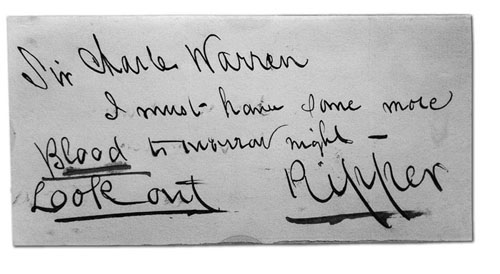
One of the Ripper letters sent to Sir Charles Warren.
Among the various suggestions that the murderer was a police officer was an unsigned letter on 15 October to the Metropolitan Police from Trowbridge, Wiltshire. It was addressed to Sir Charles Warren but was forwarded to the City Police because it referred to PC Watkins who had found Eddowes’ body. It was received on 18 October:
i feel i must for reasons which i will tell you another time if the man should prove to be the one that did the murders i mean the policeman Watkins that found the body of the woman in mitre square i want you to keep an eye on him you may think it strange i should pick out a man in the service but if he was in the ploice service or my own brother i would for the sake of the peopel try and find him out Dear Sir if he should prove to be the man or lead to the discovery you will hear from me again.
On the back page, written at an angle, was:
please be careful and keep this quiet not let him know you are watching him.
On 16 October the most sensational item of correspondence, allegedly from the killer, was received by builder and decorator George Lusk of 1 Alderney Road, Mile End, President of the Vigilance Committee. The small cardboard box contained half a human kidney that had been longitudinally divided and a letter:
From hell
Mr Lusk
Sir
I send you half the
Kidne I took from one women
prasarved it for you tother piece I
fried and ate it was very nise I
may send you the bloody knif that
took it out if you only wate a whil
longer.
Signed Catch me when
You can
Mishter Lusk.
This must have been like manna from heaven for the press who were still printing sensational and blood-curdling stories even though October was proving a rather uneventful month in the absence of further murders in Whitechapel. Lusk, after initially regarding it as a joke, finally took the letter and piece of kidney to a local doctor and then to Dr Thomas Horrocks Openshaw, the pathological curator at the London Hospital, who pronounced it to be human. From there the items were taken to Leman Street police station on 18 October. The kidney was forwarded to the City Police office at Old Jewry and the letter to Scotland Yard. On 20 October Swanson loaned the letter to McWilliam who had it photographed and returned it to Scotland Yard on 24 October. Dr Brown examined the section of kidney and he too declared it to be human. The combined medical opinion was that it was the kidney of an adult human. It was not charged with fluid (formalin) as it would have been in the case of a cadaver used for dissection in teaching, but was from a body which had been autopsied and, as such, could be obtained by any student or mortuary porter. Every effort was made to trace the sender but to no avail. McWilliam felt that it might turn out to be the act of a medical student, who would be in a position to obtain such a specimen. There was cooperation between the City and Scotland Yard and James McWilliam and Donald Swanson met daily to confer on the subject.
There is a popular misconception that Eddowes was suffering from a kidney condition known as Bright’s disease, but there is actually no evidence to show that she did. The person responsible for starting the myth is Henry Smith of the City Police. In his entertaining book From Constable To Commissioner (1910) Smith relates the story of the Lusk letter and kidney, telling how he passed the portion of kidney to Dr Gordon Brown, instructed him to consult with the most eminent men in the profession and asked him to send a report as soon as possible. Smith then went on to give the main points of the report, stating that the renal artery was 3 inches long and that 2 inches remained in Eddowes’ corpse while 1 inch was attached to the piece of kidney. However, when Dr Brown was interviewed by the press about his examination of the kidney he stated that the renal artery had been trimmed off. Smith then went on to say: ‘The kidney left in the corpse was in an advanced stage of Bright’s Disease; the kidney sent me was in an exactly similar state.’ This was simply untrue. Dr Gordon Brown said no such thing as is clear from the surviving detail in his inquest evidence. Present at the post-mortem examination on Eddowes was Dr William Sedgwick Saunders, the Analyst for the City of London, who inspected the stomach contents. In an interview with the Manchester Evening News on 19 October, he said:
You may take it that the right kidney of the woman Eddowes was perfectly normal in its structure and healthy, and by parity of reasoning you would not get much disease in the left. The liver was healthy and gave no indication that the woman drank. Taking the discovery of a kidney and supporting it to be human my opinion is that it was a student’s antic. It is quite possible for any student to obtain a kidney for the purpose.
Bright’s disease, named after Richard Bright (1789–1858) of Guy’s Hospital does not exist as a named illness today; the modern equivalent would be glomerulonephritis, which has many variants. In 1888 it was customary to describe a non-suppurative inflammation of the kidneys (nephritis) as Bright’s disease, and nearly all forms of nephritis would come under this heading. There is no evidence that Eddowes was suffering from such a condition. That having been said, it was not an uncommon illness in 1888.
The newspapers of 1888 mentioned that Dr Openshaw stated the kidney belonged to a female, that it was part of a left kidney and that the woman had been in the habit of drinking (it was reported he said it was a ‘ginny’ kidney). ‘[T]he kidney is evidently that of a person who had been a considerable drinker, as there were distinct marks of disease,’ said the Daily Telegraph. Such Sherlockian deductions could not be made from the piece of organ and Dr Openshaw was quick to deny that he had made such comments, stating that he was merely able to say that it was half of a left human kidney.7 Alcohol does not damage the kidneys and there was no such thing as a ‘ginny’ one. No doubt Smith elaborated his tale using the erroneous press reports rather than drawing on anything resembling evidence.
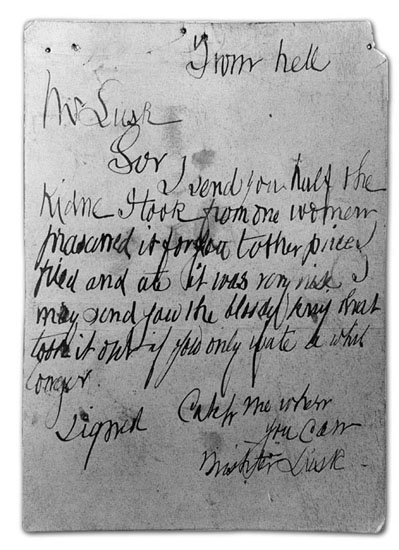
The infamous ‘From hell’ letter, sent to George Lusk of the Whitechapel Vigilance Committee on 16 October 1888 together with a section of human kidney. Initially worried about it, Lusk came to regard it as a ‘joke’ by someone at the London Hospital.
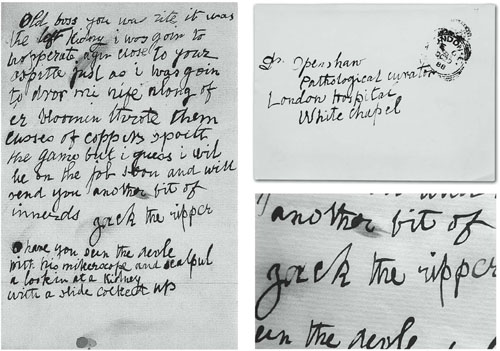
Letter, envelope and enlarged detail of Jack the Ripper correspondence sent to Dr Thomas Openshaw.
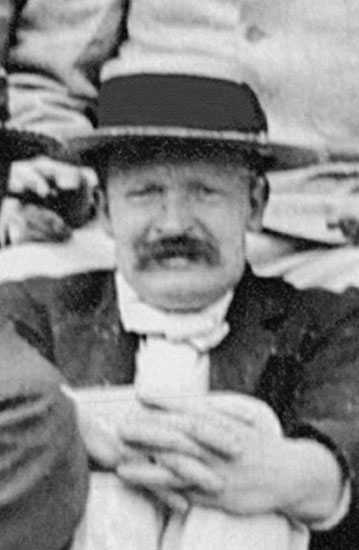
Dr Thomas Openshaw, who examined the ‘Lusk kidney’ and pronounced it human.
The third point Smith raised in his efforts to prove that the letter and piece of kidney were genuine was a statement that according to the medical experts, specifically Mr Sutton of the London Hospital, the specimen ‘had been put in spirits within a few hours of its removal from the body – thus effectually disposing of all hoaxes in connection with it’. He went on to explain that the body of anyone who had died violently was not taken direct to the dissecting-room but must await the inquest and this was never held sooner than the following day. This is simply incorrect and irrelevant. All bodies which had met with a sudden death were autopsied at a mortuary in order to establish cause of death – even if it was obvious. These examinations were carried out daily and were easily accessible to many medical men or others with permission to attend, as well as the mortuary attendants who dealt with the bodies for the doctors. It is a procedure that has led to a misunderstanding among some modern theorists who have confused these usually fresh bodies, dealt with almost every day, with the formalin-preserved cadavers used for dissection by students. The piece of kidney sent to Lusk had been steeped in spirits of wine, which was the standard medium for preserving specimens in the short term. Therefore, the kidney could easily have been obtained by any medical student, for example, from a fresh corpse. The natural way to keep it before posting would be in spirits of wine. Smith’s own man, Inspector McWilliam, allowed the possibility that it was a hoax. He said, ‘It might turn out after all, to be the act of a Medical Student who would have no difficulty in obtaining the organ in question.’ The view was endorsed by Swanson who stated that:
the result of the combined medical opinion they have taken upon it, is, that it is the kidney of a human adult, not charged with fluid, as it would have been in the case of a body handed over for the purposes of dissection to an hospital, but rather as it would be in a case where it was taken from the body not so destined. In other words similar kidneys might & could be obtained from any dead person upon whom a post-mortem had been made from any cause by students or dissecting room porter.
This, combined with the opinion of Dr Gordon Brown and Lusk, who later stated he was known at the London Hospital and believed that the kidney was sent to him as a practical joke,8 leads the authors to doubt that the ‘From hell’ communication was genuine. We can only assume that Lusk had good reason for his belief and may even have had an idea who the culprit was.
‘An Accessory’, writing on 19 October 1888 to the inspector of the Detective Department of the City Police, was another correspondent who accused an ex-policeman:
The crime committed in Mitre Square City and those in the district of Whitechapel were perpetrated by an Ex Police Constable of the Metropolitan Police who was dismissed the force through certain connection with a prostitute. The motive for the crimes is hatred and spite against the authorities at Scotland Yard one of whom is marked as a victim after which the crimes will cease.
The City Police marked this letter as having sent a copy to Scotland Yard on 20 October.
The chalking of messages on walls was obviously popular in 1888, especially after the publicity accorded to the Goulston Street writing. Even the toilet walls of the Guildhall were not spared. On 25 October 1888 Josiah E. Boys of 41 Commercial Street, E, reported in a letter to Sir James Fraser that:
whilst in the Guildhall this afternoon I had occasion to go into one of the water closets, and, upon the wall I saw written the following words, I am Jack the Ripper and intend to do another murder at the Adelphi Arches at 2. a.m. at first I was inclined to think it an hoax he also adds I will send the Ears to Colonel Frazer – I have compared the handwriting and find a striking resemblance In the formation of the letters.
On Sunday 26 October Florence Forbes Winslow, wife of the celebrated Ripper-hunting doctor, wrote from Rivercourt, Hammersmith, to make the suggestion that ‘Jack the Ripper’ lived in the north of London. She enclosed a cutting from the People of that day which reported that some two weeks previously two ladies who disembarked the train at Finchley Road had been much frightened by a well-dressed young man in their railway carriage. He had taken out a knife and conducted himself like a madman. He got out at the same station but quickly disappeared. She should not have thought much about the latest ‘Strange Affair on the North London Railway’ were it not for this incident. She felt that it was very likely that the man went to and fro to Broad Street, which, she believed, was not far from Whitechapel and she ended, ‘As I often travel alone to Finchley Road I am naturally rather alarmed.’
The enclosed cutting was entitled ‘WAS IT JACK THE RIPPER?’ and related to an incident that had occurred on the night of 25 October. A young lady, on her own, had caught a train at about 8 p.m. at Broad Street station and was alarmed by ‘a tall, gentlemanly-looking man, who wore a silk hat and carried a black bag’ who tried to enter her carriage but was put into the next one by a porter. She heard strange noises in the next carriage near Shoreditch and between there and Haggerston she was ‘much startled by the appearance of a thin white hand at the carriage window on the right side of the train’. To her further alarm ‘a few seconds later a man’s face, pale and startled looking, peered in through the glass on the opposite side, and almost petrified the young lady with fright’. She recognised him as the passenger from the next carriage and had the presence of mind to pull up the window by the strap and hold on to the leather. Apparently, as he was in a perilous position outside on the narrow footboard he was unable to enter. The train began to brake at Haggerston station and ‘the haggard and wild-looking face’ left the window. She alighted from the train, as did the stranger with his bag. She said to him, ‘You coward, to try and frighten me!’ He looked at her in a ‘dazed sort of fashion’ and slipped off among other passengers leaving the station. She burst into hysterical tears and was helped by a gentleman and his wife who listened to her story and tried to find the man without avail. The piece ended with another story of an incident that had occurred at a house in the north of London. A 16-year-old girl retired to bed with her elder sister at nearly 11 p.m. and at about 6 the next morning she awoke to find that her hair had been plaited and then cut through. A piece about 8 inches long, still plaited, was found lying on the pillow and next to it was a note: ‘This is just to show you that I am about.–The Barber.’ The bedroom door was still locked but the window, on the second floor, was open. The elder girl denied all knowledge of the affair and seemed more frightened than her sister.
Such were the bizarre incidents reported as the month drew to a close but the mystery of the murders remained as impenetrable as the October fog that drifted against the windows of Scotland Yard. The parlous state of the investigation’s affairs was summed up by Anderson in a report to the Home Office dated 23 October:
The Whitechapel Murders
At the present stage of the inquiry the best reply that can be made to the Secretary of State’s request for a report upon these cases is to send the accompanying copy of detailed reports prepared by Chief Inspector Swanson, who has special charge of the matter at this office.
I wish to guard against its being supposed that the inquiry is now concluded. There is no reason for furnishing these reports at this moment except that they have been called for.
That a crime of this kind should have been committed without any clue being supplied by the criminal, is unusual, but that five successive murders should have been committed without our having the slightest clue of any kind is extraordinary, if not unique, in the annals of crime. The result has been to necessitate our giving attention to innumerable suggestions, such as would in any ordinary case be dismissed unnoticed, and no hint of any kind, which was not obviously absurd, has been neglected. Moreover, the activity of the Police has been to a considerable extent wasted through the exigencies of sensational journalism, and the action of unprincipled persons, who, from various motives, have endeavoured to mislead us. But on the other hand the public generally and especially the inhabitants of the East End have shown a marked desire to assist in every way, even at some sacrifice to themselves, as for example in permitting their houses to be searched as mentioned at page 10 of the last report.
The vigilance of the officers engaged on the inquiry continues unabated.
R.Anderson
Oct 23/88
Clearly the police were at a loss to explain their lack of results and were painfully aware that there was still an unknown killer at large. It was not a good start for Anderson’s career as head of the CID and, unknown to him at this time, he was already being viewed by the Home Office as a potential scapegoat for failure to solve the crimes.
Things were to get worse.